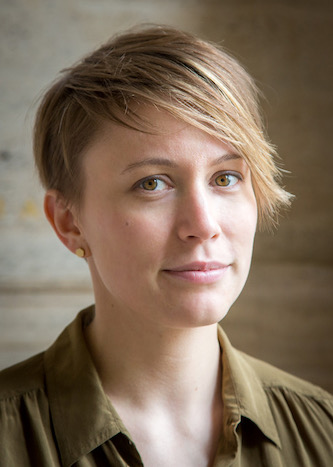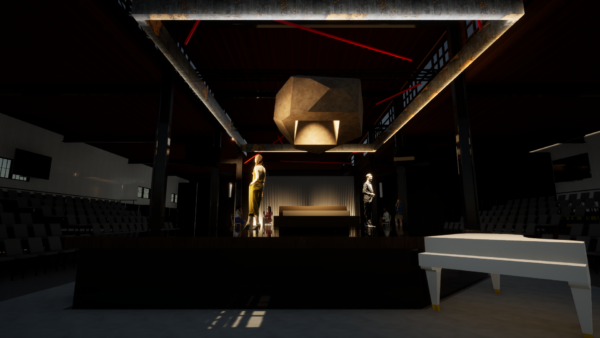Theater Interview: Set Designer Sara Brown — Alchemy is Afoot
By Robert Israel
Set designer Sara Brown creates theater wizardry with the assistance of digital tools, not a magic wand.

Set Designer Sara Brown. Photo: courtesy of the artist.
When a play works especially well, its disparate parts – script, lighting, set, music/sound, acting, costumes, technology – come together seamlessly. Yet much effort has gone into creating that illusion. The audience is the beneficiary — they never see the long hours and hard work that a cast and crew put into a production. When they exit the theater, in many cases transformed and transfixed, they believe alchemy is afoot.
Set designer Sara Brown, creates theater wizardry with the assistance of digital tools, not a magic wand. She’s a 43 year-old Minnesota-native who has lived in the Boston area since 2008. An associate professor of theater at the Massachusetts Institute of Technology, she is also a freelance designer. She has worked on, to use her words, “about 40 and 50 productions, from downtown theater to everything in between.”
Brown is in demand at several area repertory companies – Huntington Theatre Company, Trinity Rep, A.R.T., and Boston Lyric Opera — to mention a few. She defines her work as the manifestation of skills put forth in concert with other professionals who shape productions for the stage.
Arts Fuse met up with Brown for an interview at her studio/classroom at M.I.T. on Vassar Street in Cambridge.
Arts Fuse: How did you get started as a set designer?
Sara Brown: I took a rudimentary drafting class in school –it was an industrial tech class – and I liked it so much that it led me to study computer aided drafting, or CAD, and then onto more advanced training in college and in graduate school. I felt early on that it was my calling, something I wanted to for the rest of my life. I started by using pencil and paper, and later went the computer route. Working as a set designer, one learns to use as many tools as possible to get the script to the stage.
AF: Director Anne Bogart, in a recent interview with this magazine, praised your computer designs for the Boston Lyric Opera’s production of Bluebeard’s Castle/ Four Songs. She described your work as “incredible,” astonished by what you showed her during the planning stages. She called it the “brave new world” of set design.
SB: Theater directors see how a set looks in their head. As a designer, I don’t see a set in my head: I have to see it in front of me. I choose the most efficient tools to accomplish that. For Bluebeard’s Castle, we had to create several spaces – a male space, a female space, and an audience space. It’s very much like an architect who draws schematics for rooms. Measurements are taken. A map is drawn to scale. As a designer, I take into consideration the relationship of those rooms with time, because the story unfolds in the course of an evening. I create model rooms. Then I videotape it from the audience’s perspective, moving through the rooms and showing all angles – and I show this to the director, and they see the set looks from each seat in the house.

A glimpse of the set design for Boston Lyric Opera’s production of Bluebeard’s Castle/ Four Songs. Photo: courtesy of the artist
AF: Each theater space is unique, so you have to start surveying from scratch each time.
SB: Yes. So the process begins with a site visit. A rough plan is developed. A model is constructed using cardboard, metal, stick figures and Lego-like blocks to show where the audience sits, and so on. We use a tool called Twin Motion to film a video tour of the set. Understanding the physical plant of the theater itself is critical. Theaters would do themselves a great service by creating a digital model of their performing space and then make this model available to designers in advance, so we have an understanding of the theater’s ‘bones,’ or what we also call the ‘sharp elbows’ of that particular space.
AF: Given today’s technology, isn’t there a way to create a design template in order to get at tasks quicker?
SB: A designer moves from the general to the specific. You cannot cut corners. If you try to cut corners, you run into trouble. A template wouldn’t be useful here. You have a conversation with the director, you pass ideas back and forth, you give them something concrete to look at and to respond to, they see it before their eyes, and, throughout, you are constantly tweaking, changing, and reshaping it. It’s an evolutionary process. And when you’re done, you send it off to the shop to get it built.
Below are computer renderings of the set for Bluebeard’s Castle/Four Songs:
AF: How do students at M.I.T. respond to your work?
SB: We are located on the outskirts of the campus, yet students seek us out and they find us. I’m incredibly lucky to have such bright, curious students who love working with their hands. They come from around the world. I find myself learning from them just as they are learning from me.
AF: What’s up next for you?
SB: I’m working on the set design for the Huntington Theatre Company’s production of The Lehman Trilogy, which opens in June. I’ve met with the director, Carey Perloff, so we’re on our way. And I’m continuing to work with gifted students and brilliant colleagues, following my curiosity, and honing in on my values. I consider myself fortunate to be able to do this work.
Robert Israel, an Arts Fuse contributor since 2013, can be reached at risrael_97@yahoo.com.
